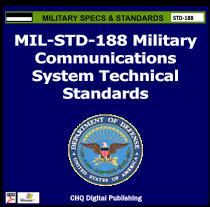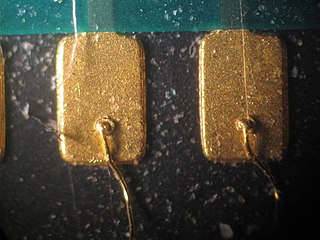Related Research Articles

Configuration management (CM) is a systems engineering process for establishing and maintaining consistency of a product's performance, functional, and physical attributes with its requirements, design, and operational information throughout its life. The CM process is widely used by military engineering organizations to manage changes throughout the system lifecycle of complex systems, such as weapon systems, military vehicles, and information systems. Outside the military, the CM process is also used with IT service management as defined by ITIL, and with other domain models in the civil engineering and other industrial engineering segments such as roads, bridges, canals, dams, and buildings.

MIL-STD-188 is a series of U.S. military standards relating to telecommunications.
A mechanical or physical shock is a sudden acceleration caused, for example, by impact, drop, kick, earthquake, or explosion. Shock is a transient physical excitation.

Wire bonding is the method of making interconnections between an integrated circuit (IC) or other semiconductor device and its packaging during semiconductor device fabrication. Although less common, wire bonding can be used to connect an IC to other electronics or to connect from one printed circuit board (PCB) to another. Wire bonding is generally considered the most cost-effective and flexible interconnect technology and is used to assemble the vast majority of semiconductor packages. Wire bonding can be used at frequencies above 100 GHz.
MIL-STD-1553 is a military standard published by the United States Department of Defense that defines the mechanical, electrical, and functional characteristics of a serial data bus. It was originally designed as an avionic data bus for use with military avionics, but has also become commonly used in spacecraft on-board data handling (OBDH) subsystems, both military and civil. It features multiple redundant balanced line physical layers, a (differential) network interface, time division multiplexing, half-duplex command/response protocol, and can handle up to 30 Remote Terminals (devices). A version of MIL-STD-1553 using optical cabling in place of electrical is known as MIL-STD-1773.
MIL-STD-498 (Military-Standard-498) was a United States military standard whose purpose was to "establish uniform requirements for software development and documentation." It was released Nov. 8, 1994, and replaced DOD-STD-2167A, DOD-STD-7935A, and DOD-STD-1703. It was meant as an interim standard, to be in effect for about two years until a commercial standard was developed.
A United States defense standard, often called a military standard, "MIL-STD", "MIL-SPEC", or (informally) "MilSpecs", is used to help achieve standardization objectives by the U.S. Department of Defense.
Environmental stress screening (ESS) refers to the process of exposing a newly manufactured or repaired product or component to stresses such as thermal cycling and vibration in order to force latent defects to manifest themselves by permanent or catastrophic failure during the screening process. The surviving population, upon completion of screening, can be assumed to have a higher reliability than a similar unscreened population.

MIL-STD-810, Environmental Engineering Considerations and Laboratory Tests, is a United States Military Standard that emphasizes tailoring an equipment's environmental design and test limits to the conditions that it will experience throughout its service life, and establishing chamber test methods that replicate the effects of environments on the equipment rather than imitating the environments themselves. Although prepared specifically for military applications, the standard is often used for commercial products as well.

The human-body model (HBM) is the most commonly used model for characterizing the susceptibility of an electronic device to damage from electrostatic discharge (ESD). The model is a simulation of the discharge which might occur when a human touches an electronic device.
The Institute of Environmental Sciences and Technology (IEST) is a non-profit, technical society. It's where professionals who impact controlled environments connect, gain knowledge, receive solid advice, and work together to create industry best practices. The organization uniquely serves environmental test engineers, qualification engineers, cleanroom professionals, those who work in product testing and evaluation, and others who work across a variety of industries, including: acoustics, aerospace, automotive, biotechnology/bioscience, climatics, cleanroom operations/design/equipment/certification, dynamics, filtration, food processing, HVAC design, medical devices, nanotechnology, pharmaceutical, semiconductors/microelectronics, and shock/vibration. Information on ISO 14644 and ISO 14698 standards can be found through this organization.
ISO 14644 Standards were first formed from the US Federal Standard 209E Airborne Particulate Cleanliness Classes in Cleanrooms and Clean Zones. The need for a single standard for cleanroom classification and testing was long felt. After ANSI and IEST petitioned to ISO for new standards, the first document of ISO 14644 was published in 1999, ISO 14644-1.
The military standard referred to as MIL-E-7016F, Electric Load and Power Source Capacity, Aircraft, Analysis of" addresses the methods and analysis of electric loads and source capacity on military aircraft. The use of the document is approved for use by all departments and agencies of the United States Department of Defense (DoD). Although prepared specifically for DoD applications, the standard may be tailored for commercial applications as well.
The MIL-STD-883 standard establishes uniform methods, controls, and procedures for testing microelectronic devices suitable for use within military and aerospace electronic systems including basic environmental tests to determine resistance to deleterious effects of natural elements and conditions surrounding military and space operations; mechanical and electrical tests; workmanship and training procedures; and such other controls and constraints as have been deemed necessary to ensure a uniform level of quality and reliability suitable to the intended applications of those devices. For the purpose of this standard, the term "devices" includes such items as monolithic, multichip, film and hybrid microcircuits, microcircuit arrays, and the elements from which the circuits and arrays are formed. This standard is intended to apply only to microelectronic devices.
MIL-PRF-38535 is a United States military specification that establishes the general performance and verification requirements of single die integrated circuit device type electronics. It is a performance-based specification document defining the general requirements, as well as the quality assurance and reliability requirements, for the manufacture of microelectronic or integrated circuits used in military applications and high-reliability microcircuit application programs.

Flatpack is a US military standardized printed-circuit-board surface-mount-component package. The military standard MIL-STD-1835C defines: Flat package (FP). A rectangular or square package with leads parallel to base plane attached on two opposing sides of the package periphery.
Reliability of semiconductor devices can be summarized as follows:
- Semiconductor devices are very sensitive to impurities and particles. Therefore, to manufacture these devices it is necessary to manage many processes while accurately controlling the level of impurities and particles. The finished product quality depends upon the many layered relationship of each interacting substance in the semiconductor, including metallization, chip material and package.
- The problems of micro-processes, and thin films and must be fully understood as they apply to metallization and wire bonding. It is also necessary to analyze surface phenomena from the aspect of thin films.
- Due to the rapid advances in technology, many new devices are developed using new materials and processes, and design calendar time is limited due to non-recurring engineering constraints, plus time to market concerns. Consequently, it is not possible to base new designs on the reliability of existing devices.
- To achieve economy of scale, semiconductor products are manufactured in high volume. Furthermore, repair of finished semiconductor products is impractical. Therefore, incorporation of reliability at the design stage and reduction of variation in the production stage have become essential.
- Reliability of semiconductor devices may depend on assembly, use, and environmental conditions. Stress factors affecting device reliability include gas, dust, contamination, voltage, current density, temperature, humidity, mechanical stress, vibration, shock, radiation, pressure, and intensity of magnetic and electrical fields.

An ESD simulator, also known as an ESD gun, is a handheld unit used to test the immunity of devices to electrostatic discharge (ESD). These simulators are used in special electromagnetic compatibility (EMC) laboratories. ESD pulses are fast, high-voltage pulses created when two objects with different electrical charges come into close proximity or contact. Recreating them in a test environment helps to verify that the device under test is immune to static electricity discharges.
An operating temperature is the temperature at which an electrical or mechanical device operates. The device will operate effectively within a specified temperature range which varies based on the device function and application context, and ranges from the minimum operating temperature to the maximum operating temperature. Outside this range of safe operating temperatures the device may fail.
A low magnetic electric motor is an AC or DC motor with a reduced magnetic stray field signature.
References
- ↑ "Test Method Standard Microelectronic Circuits MIL-STD-883J w/Change 5" (PDF). Department of Defense. Archived from the original (PDF) on 4 March 2016. Retrieved 17 December 2015.
- ↑ "TEST METHOD STANDARD TEST METHODS FOR SEMICONDUCTOR DEVICES MIL-STD-750F" (PDF). Department of Defense. Archived from the original (PDF) on 2015-12-22. Retrieved 2015-12-17.
| This standards- or measurement-related article is a stub. You can help Wikipedia by expanding it. |